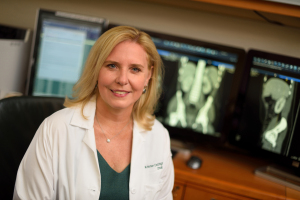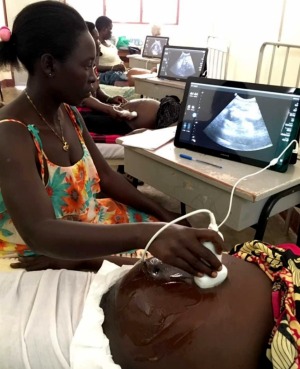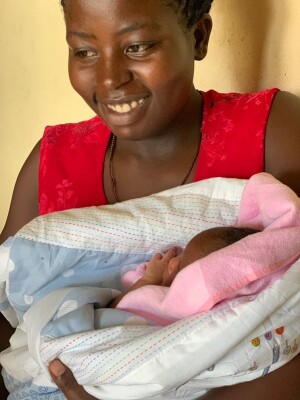
For over a decade, Imaging the World has
been bringing ultrasound access to expecting
mothers in Uganda.
been bringing ultrasound access to expecting
mothers in Uganda.
Making a difference in Africa with ultrasound access
December 01, 2019
by Sean Ruck, Contributing Editor
The woman arrived near death after being in labor for four days. An ultrasound revealed something no one had been aware of up until that point — she was pregnant with twins. The problem was that one of the twins was breeched, preventing either from being delivered. With the knowledge provided by the ultrasound scan, the attending midwife was able to manually turn the baby, saving the lives of mother and twins. For Dr. Kristen DeStigter, president and co-founder of Imaging the World, and chair and healthcare service chief of radiology at University of Vermont, that was the case that stuck with her the most. “We’ve followed them over the years and I have seen the twins grow. I know we’ve impacted many lives, but that was sort of patient zero for me,” she said.
DeStigter’s organization works to bring ultrasound imaging to communities in need. It has been doing its work in Uganda for more than a decade and has recently has made inroads in Malawi as well. But the story really started in Kenya. Years before Imaging the World was founded, DeStigter was a med school student at Case Western Reserve University, working in the parasite lab of what was then called the Department of Geographic Medicine. The lab was conducting a Phase II drug study of a treatment for schistosomiasis, a disease caused by parasites released by freshwater snails. That’s what brought her to East Africa for the first time. It was in the late 1980s in a remote area of Kenya, about 14 hours by car to the nearest hospital. “We parked two Land Rovers with a tarp over the top and used a generator to run an ultrasound machine to check the effectiveness of the treatment by looking at the liver and the kidneys and bladder,” she recalled.
When their research day ended, the doctors on the team would run a clinic. The people they’d see would present with the usual suspects of malaria, diarrhea and pneumonia, but the ultrasound machines would tell another tale that DeStigter described as heart wrenching. “We would see complicated pregnancies, things like ectopic pregnancies, breech presentations, placental abnormalities, and infections. And knowing that without proper care, these women who were 14 hours away from the nearest surgery or C-section would likely die. I carried that with me for a long time.”
After her time in Kenya, she dabbled with outreach for years, notably in Honduras, but she found it problematic. “It was brief work – going in with a team of people and then back out, but it never felt like it was something sustainable and impactful from a longitudinal perspective. When I came to Vermont about 20 years ago, there was sort of a breakthrough. The technology had started to change around that time. Ultrasound was getting smaller and less expensive. The portable handheld devices we use now could be solar-powered, cellphones became ubiquitous even in the most remote corners of the world and software tools allowed us to capture images in a different way at the point of care.”
So with colleagues both here and around the country, DeStigter formed the non-profit Imaging the World. The organization’s initial funding came from the Gates Foundation. The goal was to mitigate the lack of formal training in low resource areas. Simple in statement, incredibly challenging in practice. A big part of the problem was the fact that the majority of the population in Uganda lives in rural areas, but most of the country’s medical professionals live in the urban areas. So the focus was put into training the midwives and nurses who work at the rural clinics. “We trained the people we could train,” DeStigter said.
There was also training of sorts required of the general public. When ultrasound was first brought to the community health centers, many perceived it as magic, “and not in a good way,” DeStigter said. “They thought it could burn them, make them infertile, or kill their babies. So it required a large amount of focused community outreach. We partnered with the community health workers to go around and get the word out there. Slowly, over time, people in the community started to see that women who got the scan were having better outcomes. We started to see an increase in trust of the healthcare system.”
The efforts started to pay off. The team observed that a prenatal ultrasound scan often changes pregnancy management and saves lives. Later studies peg the percentage at about 25 percent of cases getting a change to the management of a pregnancy. But DeStigter didn’t want a repeat of past outreaches. She didn’t want the team to work in the country for short periods and then leave the health of women up to fate when the medical professional departed, taking any chance of additional training for the nurses and midwives with them. Instead, the organization worked to solve the problem of providing continuous education to retain skills and deliver on quality assurances. The group realized repeat visits by experts would be too expensive. Video conferencing required clearing technological hurdles that were set too high — namely the need for robust internet connections and costly data programs, making it a no-go in the rural areas in need. And bringing the nurses and midwives to some centralized location for training removed them from the field, yet they were often the only ones providing daily care at the rural clinics, so that wasn’t an option either. “What we did do was to use cine clips. They are photos taken in six sweeps over the pregnant abdomen. So the transducer captures all the information in a series of static images,” DeStigter said. Those images can be stitched together like a high-tech flipbook to make it look like it’s a video rather than a series of still-photos. Users can scroll forward and back, zoom in, take measurements and really study the image. The cines are anonymized for compliance and they’re compressed to the size of a photo and sent for secure, remote review by experts to make sure safe and reliable care is being provided.
From a financial sustainability side, Imaging the World has a business model set up at each facility, which charges a small fee for a scan. “The difference between fee-for-service here at home and there is that there, the fee is determined by the community,” DeStigter said. So it’s deemed affordable by the community members and they pay a fee that supports the scanning’s use of the consumables — the ultrasound gel that’s required, the power, the network, and supervision costs. According to DeStigter, generally about a year-and-a-half into a program, a clinic that has integrated ultrasound into its care is fully financially sustainable. And the management isn’t all coming from Vermont where the headquarters is based. “We have a great team — Imaging the World Africa — that’s in Kampala, they run the operations. We have a Ugandan surgeon who’s the clinical director of the program,” said DeStigter. “We’ve trained hundreds of nurses and midwives over the years and it’s difficult to provide the precise number, but we know we’ve done more than 300,000 obstetric scans in the last 12 years, identifying complications that need to be referred to a higher level of care.”
Before the organization introduces ultrasound at a site, they confirm that the site has a stable referral system in place. They won’t integrate ultrasound at any facility where there’s not access to a higher level of care. Sometimes efforts are made to build referral capacity to allow for integration of ultrasound. But it’s not just the general community that’s benefitting. There are also professionals taking steps toward a better life; of the nurses that have been trained, six enrolled in medical school. “We believe this will improve the line of succession. We have an exit strategy. Eventually, we’ll be able to entirely hand this off to the Ugandans and then Malawians, and so on,” said DeStigter.
When it comes to getting support for Imaging the World’s work, DeStigter said the organization is not looking for older equipment since it can be challenging to find parts, people with the knowledge to repair the equipment or even to get customer support from the manufacturer on old equipment. Instead, she prefers either new equipment, or funding for the purchase of equipment.
In the future, DeStigter hopes to get the funding to expand their efforts to an area where there isn’t exactly an exit strategy needed, and that’s because it’s already where she lives, or more broadly, where she’s a citizen. “We’re looking to expand into rural areas even in high-income countries. By that, I mean the United States. We’ve cultivated a program that works really well and I would really like to see it be operational here. There are barriers to that, including nurses and midwives being able to scan independently in this country, but we need to find a way to improve outcomes at home too.”
DeStigter’s organization works to bring ultrasound imaging to communities in need. It has been doing its work in Uganda for more than a decade and has recently has made inroads in Malawi as well. But the story really started in Kenya. Years before Imaging the World was founded, DeStigter was a med school student at Case Western Reserve University, working in the parasite lab of what was then called the Department of Geographic Medicine. The lab was conducting a Phase II drug study of a treatment for schistosomiasis, a disease caused by parasites released by freshwater snails. That’s what brought her to East Africa for the first time. It was in the late 1980s in a remote area of Kenya, about 14 hours by car to the nearest hospital. “We parked two Land Rovers with a tarp over the top and used a generator to run an ultrasound machine to check the effectiveness of the treatment by looking at the liver and the kidneys and bladder,” she recalled.
When their research day ended, the doctors on the team would run a clinic. The people they’d see would present with the usual suspects of malaria, diarrhea and pneumonia, but the ultrasound machines would tell another tale that DeStigter described as heart wrenching. “We would see complicated pregnancies, things like ectopic pregnancies, breech presentations, placental abnormalities, and infections. And knowing that without proper care, these women who were 14 hours away from the nearest surgery or C-section would likely die. I carried that with me for a long time.”
Imaging the World began with the simple goal of mitigating the lack of formal training in low resource areas.
So with colleagues both here and around the country, DeStigter formed the non-profit Imaging the World. The organization’s initial funding came from the Gates Foundation. The goal was to mitigate the lack of formal training in low resource areas. Simple in statement, incredibly challenging in practice. A big part of the problem was the fact that the majority of the population in Uganda lives in rural areas, but most of the country’s medical professionals live in the urban areas. So the focus was put into training the midwives and nurses who work at the rural clinics. “We trained the people we could train,” DeStigter said.
There was also training of sorts required of the general public. When ultrasound was first brought to the community health centers, many perceived it as magic, “and not in a good way,” DeStigter said. “They thought it could burn them, make them infertile, or kill their babies. So it required a large amount of focused community outreach. We partnered with the community health workers to go around and get the word out there. Slowly, over time, people in the community started to see that women who got the scan were having better outcomes. We started to see an increase in trust of the healthcare system.”
Slowly, over time, people in the community started to see that women who got the scan were having better outcomes," said DeStigter. "We started to see an increase in trust of the healthcare system.â€
From a financial sustainability side, Imaging the World has a business model set up at each facility, which charges a small fee for a scan. “The difference between fee-for-service here at home and there is that there, the fee is determined by the community,” DeStigter said. So it’s deemed affordable by the community members and they pay a fee that supports the scanning’s use of the consumables — the ultrasound gel that’s required, the power, the network, and supervision costs. According to DeStigter, generally about a year-and-a-half into a program, a clinic that has integrated ultrasound into its care is fully financially sustainable. And the management isn’t all coming from Vermont where the headquarters is based. “We have a great team — Imaging the World Africa — that’s in Kampala, they run the operations. We have a Ugandan surgeon who’s the clinical director of the program,” said DeStigter. “We’ve trained hundreds of nurses and midwives over the years and it’s difficult to provide the precise number, but we know we’ve done more than 300,000 obstetric scans in the last 12 years, identifying complications that need to be referred to a higher level of care.”
Smaller and less expensive ultrasound designs made it possible to provide scans at the point of care in remote regions.
When it comes to getting support for Imaging the World’s work, DeStigter said the organization is not looking for older equipment since it can be challenging to find parts, people with the knowledge to repair the equipment or even to get customer support from the manufacturer on old equipment. Instead, she prefers either new equipment, or funding for the purchase of equipment.
In the future, DeStigter hopes to get the funding to expand their efforts to an area where there isn’t exactly an exit strategy needed, and that’s because it’s already where she lives, or more broadly, where she’s a citizen. “We’re looking to expand into rural areas even in high-income countries. By that, I mean the United States. We’ve cultivated a program that works really well and I would really like to see it be operational here. There are barriers to that, including nurses and midwives being able to scan independently in this country, but we need to find a way to improve outcomes at home too.”



